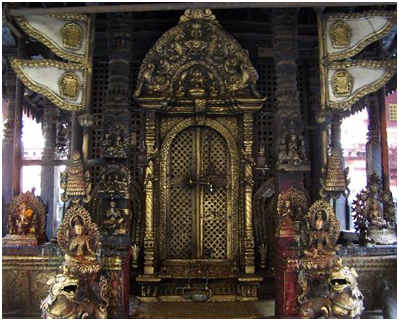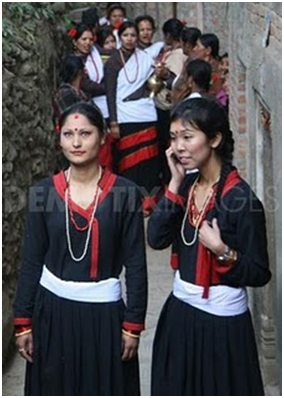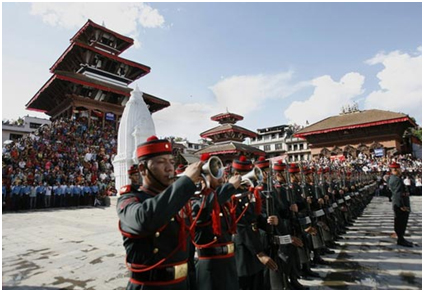- Home |
- Why With Us |
- About Us |
- Booking |
- Contact Us |
- Site Map
- Home
-
Nepal
-
Trekking
- Arun Valley with Gokyo Lakes
- Everest Base Camp Trek
- Everest- A Living Culture Exploration
- Everest Explore
- Everest Base Camp (via Thame) Trek
- Everest Base Camp with Kala Patthar
- Everest Comfort Trek
- Everest High Passes with Ama Dablam Base Camp
- Everest Mani Rimdu Festival Trek
- Everest Nagpa La Trek
- Everest with three high passes
- Gokyo Ri, Chola Pass & Chukung Ri with Kala Patthar
- Gokyo with Everest Base Camp
- Jomsom - Muktinath
- Jomsom - Muktinath
- Khayar Lake Trek
- Manaslu and Tsum Valley with Larkya La
- Upper Mustang Trek
- Manaslu High Circuit
- Manaslu, Tilicho Pass & Upper Mustang
- Annapurna Base Camp Trek
- The Annapurna Circuit Trek
- Annapurna Panorama
- Nar and Phu Valley Trekking
- Nepal Rhododendron Trek
- Royal Trek
- Saribung Trek and Expedition
- Annapurna Sanctuary Trek
- The Annapurna Sunrise Trek
- Expedition
-
Rafting
-
Peak Climbing
-
Tours
- Kathmandu-Chitwan-Jungle Tour with visit to Pokhara
- Dawn to Dusk Tour
- Historical, Natural & Cultural Tour with Camping
- Kathmandu Valley Temple Tour
- Temple - Panorama - Jungle Tour
- Taste of Nepal
- Central Nepal Tour
- Explore Nepal Tour & Trek
- Nepal Cross-country Tour
- Best of Nepal Tour & Treks
- Kathmandu valley rim Tour & Treks
- Nepal Culture Tour
- Introduction to Nepal Tour & Treks
- Nepal at a glance Tour & Treks
- Wonders of Nepal Tour & Treks
- Glimpses of Nepal Tour & Treks
- Through the Silhouette Tour & Treks
- Tent and Temple Tour
- Kathmandu-Chitwan-Pokhara Tour
- Historical, Cultural City and Jungle Tour
- Nepal Wildlife Tour
- Nepal Panorama Historical Tour
- Nepal Adventure Tour
- Nepal Pilgrimage Tour
- Ghalegaun-Ghanapokhara Homestay Tour
- Jungle Safari
- Adventure Sports
-
Trekking
- Tibet
-
Bhutan
-
India
- Yoga Tour
- About Us
-
The Great Himalayan Trail
-
Short Tours/Treks

Kathmandu Valley World Heritage Sites
 The cultural heritage of the Kathmandu Valley is illustrated by seven groups of monuments and buildings which display the full range of historic and artistic achievements for which the Kathmandu Valley is world famous. The seven include the Durbar Squares of Hanuman Dhoka (Kathmandu), Patan and Bhaktapur, the Buddhist stupas of Swayambhu and Bauddhanath and the Hindu temples of Pashupati and Changu Narayan.
The cultural heritage of the Kathmandu Valley is illustrated by seven groups of monuments and buildings which display the full range of historic and artistic achievements for which the Kathmandu Valley is world famous. The seven include the Durbar Squares of Hanuman Dhoka (Kathmandu), Patan and Bhaktapur, the Buddhist stupas of Swayambhu and Bauddhanath and the Hindu temples of Pashupati and Changu Narayan.
The Monumental Zones represent the highly developed architectural expression of religious, political and cultural life of Kathmandu Valley, with a concentration of monuments unique and unparalleled in the world. It is the principal centre of settlement in the hill area of Nepal and one of the prime cultural foci of the Himalayas. Pashupatinath is also Nepal's most renowned Hindu creation site. Changu Narayan Temple is an impressive double-roofed temple which is said to be the most ancient Vishnu temple in Kathmandu Valley.
Kathmandu, the capital, is the political, commercial and cultural hub of Nepal. Kathmandu is an exotic and fascinating showcase of a very rich culture, art and tradition. The valley, roughly an oval bowl, is encircled by a range of green terraced hills and dotted by compact clusters of red tiled-roofed houses. A remarkable legend says that the valley was once covered by a lake until the Bodhisattva Manjushri raised his sword of wisdom and sliced a passage through the mountain walls, draining the water and creating the first settlements.
The valley embraces most of Nepal's ethnic groups, but Newars are the indigenous inhabitants and the creators of the valley's splendid civilization. Kathmandu Valley is composed of seven Monumental Zones with three historical palaces within their essential urban settings (Kathmandu, Patan and Bhaktapur), two Hindu centres (Pashupatinath and Changu Narayana), and two Buddhist centres (Swayambunath and Boudhanath ).
 The city of Kathmandu is a melting pot for the nation's population, not only today but also in times past, which probably explains the rich cultural heritage of the city. Kathmandu with its unique architectural heritage, palaces, temples and courtyards has inspired many writers, artists, and poets, both foreign and Nepalese. It boasts a unique symbiosis of Hinduism, Buddhism and Tantrism in its culture, which is still as alive today as it was hundreds of years ago. The religious influence can be openly seen in the city. Most of the principal monuments are in Durbar Square , the social, religious and urban focal point of the city, built between the 12th and the 18th centuries by the ancient Malla kings of Nepal. Some of the most interesting are the Taleju Temple, Kal Bhairab, Nautalle Durbar, Coronation Nasal Chowk, and the Gaddi Baithak, the statue of King Pratap Malla, the Big Bell, Big Drum and the Jaganath Temple.
The city of Kathmandu is a melting pot for the nation's population, not only today but also in times past, which probably explains the rich cultural heritage of the city. Kathmandu with its unique architectural heritage, palaces, temples and courtyards has inspired many writers, artists, and poets, both foreign and Nepalese. It boasts a unique symbiosis of Hinduism, Buddhism and Tantrism in its culture, which is still as alive today as it was hundreds of years ago. The religious influence can be openly seen in the city. Most of the principal monuments are in Durbar Square , the social, religious and urban focal point of the city, built between the 12th and the 18th centuries by the ancient Malla kings of Nepal. Some of the most interesting are the Taleju Temple, Kal Bhairab, Nautalle Durbar, Coronation Nasal Chowk, and the Gaddi Baithak, the statue of King Pratap Malla, the Big Bell, Big Drum and the Jaganath Temple.
Another intriguing piece here is the 17th-century stone inscription that is set into the wall of the palace, with writings in 15 languages. It is believed that if anybody deciphers this entire inscription, milk would flow from the spout, which lies just below the unscripted stone wall. Some people say that the inscription contains coded directions to a treasure that King Pratap Malla has buried beneath Mohan Chowk of Durbar Square.
Lalitpur or Patan, just across the holy Bagmati River about 14 km east of Kathmandu city, is a fabulous city of great historic and cultural interest. Bhaktapur (Bhadgaon) is situated at an altitude of 1,401 m. Shaped liked a conch-shell, Bhaktapur means the 'city of devotees'.
Pashupatinath, 5 km north-east of Kathmandu Valley, is one of the most important Hindu temples. It is Nepal's most sacred Hindu shrines and one of the subcontinent's greatest Shiva sites, a sprawling collection of temples, ashrams, images and inscriptions raised over the centuries along the banks of the sacred Bagmati river.
Source: UNESCO/CLT/WHC
Historical Description
 The Kathmandu Valley has been the politically and culturally dominating part of Nepal. Its legendary and documented histories are so interrelated that these are difficult to separate. A political establishment of the area is dated to the beginning of the Christian era, the Kirati period. This was followed by the Kichchhavi Dynasty from the 3rd to 9th centuries. Patan is believed to have expanded into a consolidated town by the end of the 7th century. The town of Kathmandu was established by a later Lichchhavi king. After the 9th century, there is a dark period until 14th century and the arrival of the Mallas, which is an important period for the flourishing of Nepalese art and architecture. These developed into a growing spiritual orientation towards Tantrism, making it difficult to separate purely Buddhist from purely Hindu art. From the middle of the 13th century, the city of Bhadgaon (Bhaktapur) prospered and became a major training centre. The valley was divided into three rival kingdoms, competing between themselves and bringing the artistic expressions to the highest point by the mid 18th century. In 1769 the valley was conquered and united by a leader coming from the outside, Prithvi Narayan Shah. He made Kathmandu his royal city, and the Hanuman Dhoka Palace his residence. In 1833 and 1934, two catastrophic earthquakes brought destruction, and some of the monuments had to be rebuilt using much of the original elements and decoration.
The Kathmandu Valley has been the politically and culturally dominating part of Nepal. Its legendary and documented histories are so interrelated that these are difficult to separate. A political establishment of the area is dated to the beginning of the Christian era, the Kirati period. This was followed by the Kichchhavi Dynasty from the 3rd to 9th centuries. Patan is believed to have expanded into a consolidated town by the end of the 7th century. The town of Kathmandu was established by a later Lichchhavi king. After the 9th century, there is a dark period until 14th century and the arrival of the Mallas, which is an important period for the flourishing of Nepalese art and architecture. These developed into a growing spiritual orientation towards Tantrism, making it difficult to separate purely Buddhist from purely Hindu art. From the middle of the 13th century, the city of Bhadgaon (Bhaktapur) prospered and became a major training centre. The valley was divided into three rival kingdoms, competing between themselves and bringing the artistic expressions to the highest point by the mid 18th century. In 1769 the valley was conquered and united by a leader coming from the outside, Prithvi Narayan Shah. He made Kathmandu his royal city, and the Hanuman Dhoka Palace his residence. In 1833 and 1934, two catastrophic earthquakes brought destruction, and some of the monuments had to be rebuilt using much of the original elements and decoration.
|
Name & Location |
Coordinates |
Area |
Date Inscribed |
|
Hanuman Dhoka |
N27 42 14 E85 18 30 |
Property: 5.09 Ha |
1979 |
|
Patan Durbar Square |
N27 40 36 E85 19 47 |
Property: 5.3 Ha |
1979 |
|
Bhaktapur Durbar Square |
N27 40 16 E85 25 54 |
Property: 3.61 Ha |
1979 |
|
Swayambhu |
N27 42 52 E85 17 33 |
Property: 32.63 Ha |
1979 |
|
Bauddhanath |
N27 43 16 E85 21 51 |
Property: 1.27 Ha |
1979 |
|
Pashupati |
N27 41 09 E85 20 12 |
Property: 83.55 Ha |
1979 |
|
Changunarayan |
N27 42 58 E85 25 48 |
Property: 35.92 Ha |
1979 |

- History
- Overview
- Ancient Nepal
- The Early Kingdom of the Licchavis
- Medieval Nepal, 750-1750
- The Malla Kings
- The Three Kingdoms
- The Making of Modern Nepal
- The Struggle for Power
- The Enclosing of Nepal
- Infighting among Aristocratic Factions
- Rana Rule
- The Ranas
- The Growth of Political Parties
- The Return of the King
- The Democratic Experiment
- The Panchayat System under King Mahendra
- King Birendra
- Movement to restore democracy
- Maoist Insurgency
- Struggle for Democracy
- King's Direct Rule
- People's Movement
- The Constitutional Assembly Election
- Government and Political Conditions
- Geography
- Festivals of Nepal
- Overview
- Bada Dashain (September-October)
- Sri Panchami or Basanta Panchami
- Tihar and Laxmi Puja - festival of lights (Oct-Nov)
- Maghe Sankranti
- Naga Panchami
- Janai Poornima (Rokshya Bandhon)
- Gaijatra
- Pancha Dan
- Teej and Rishi Panchani
- Indrajatra
- Ghanta Karna
- Buddha Jayanti
- Maha Shivaratri
- Phagu Poornima or Holy
- Ghode Jatra
- Chaite Dashain
- Nava Varsha / New Year
- Festival of Seto Machhendranath
- Matatirtha Aunsi or Mother\'s Day
- Bala Chaturdashi
- Sri Krishna Janmastami
- Rama Nawami
- Mani Rimdu festival - Everest Region
- Tiji Festival, Mustang
- Dumje Festival - Everest Region
- Flora and Fauna of Nepal
- Flowering Plants of Nepal
- Getting in to Nepal
- Climate
- Nepal Visa Procedures
- Nepalese Embassies and Consulates Abroad
- Places visit in Nepal
- Orchids of Nepal
- World Heritage Sites of Nepal
Trekking in Nepal
Expeditions In Nepal
Rafting in Nepal
Tours in Nepal
All rights reserved.



